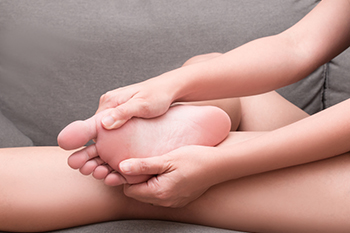

Pain in the ball of the foot can have a variety of causes including intense physical activity, having a high foot arch, a stress fracture, wearing shoes that are too small and/or non-supportive, wearing high heels, or being obese. Other foot conditions, such as sesamoiditis, can also lead to similar pain. Sesamoiditis is inflammation of the sesamoid bones that are connected to tendons instead of other bones. It is common among ballet dancers and runners who do high impact activity. Generally, it is felt as aching in the padding below the toes. Sometimes there is shooting pain or numbness when the toes are flexed where it may feel like there is a pebble in the shoe. The discomfort might disappear when we are off our feet but return once activities are resumed. If you feel pain in the ball of your foot, it is suggested you make an appointment with a podiatrist who can help diagnose the problem and obtain treatment that is right for you
Sesamoiditis is an unpleasant foot condition characterized by pain in the balls of the feet. If you think you’re struggling with sesamoiditis, contact one of our podiatrists of Grand Blanc Family Footcare. Our doctors will treat your condition thoroughly and effectively.
Sesamoiditis
Sesamoiditis is a condition of the foot that affects the ball of the foot. It is more common in younger people than it is in older people. It can also occur with people who have begun a new exercise program, since their bodies are adjusting to the new physical regimen. Pain may also be caused by the inflammation of tendons surrounding the bones. It is important to seek treatment in its early stages because if you ignore the pain, this condition can lead to more serious problems such as severe irritation and bone fractures.
Causes of Sesamoiditis
Treatment for sesamoiditis is non-invasive and simple. Doctors may recommend a strict rest period where the patient forgoes most physical activity. This will help give the patient time to heal their feet through limited activity. For serious cases, it is best to speak with your doctor to determine a treatment option that will help your specific needs.
If you have any questions please feel free to contact our office located in Grand Blanc, MI . We offer the newest diagnostic and treatment technologies for all your foot and ankle needs.